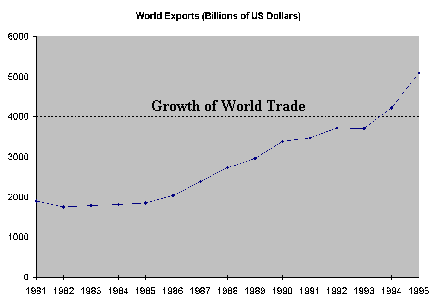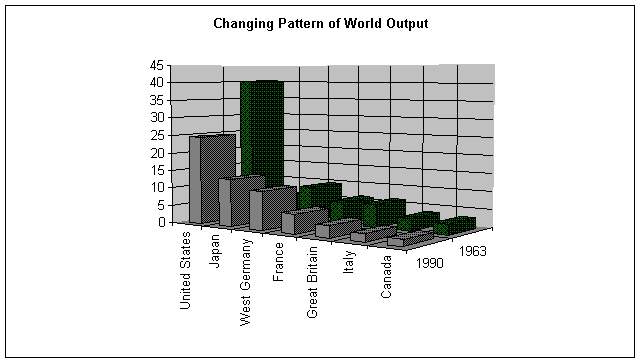
Globalization – The Catalyst for Change
Globalization can be defined as the improving ability of individuals and businesses to reside in or do business in countries other than their home country and the increasing interaction of people, businesses and governments across national borders.
Globalization is not new. From prehistoric times, people have traded goods across wide areas. Columbus’s discovery of America was a result of a globalization attempt by Spain. The British Empire was a result of globalization of production activities. Globalization has ebbed and waned over the ages. Since World War II globalization has been on a continual rise. The emphasis has been on trade by firms. Government’s role has been to set an environment to allow the firms to operate across national boundaries.
The driving forces for globalization include the following:
| Media communications share information about standards of living and qualities of life. Movies and television shows from the United States are shown all over the world. These shows demonstrate a standard of living and a quality of life that people try to emulate. This results in pressure on governments to establish an environment in which people have the opportunity to try to improve their standard of living. These shows also establish standards for quality of life including personal freedom and exert pressure on governments to move towards the democratic model of government. | |
| Media communications, especially business magazines and books, share information about business methods and opportunities. This provides a sharing of best business practices and encourages competition among businesses in various countries. Business firms put pressure on government to improve the business environment so that they can compete in the global market place. | |
| Information technology is improving the ability of firms to conduct business at multiple locations across the globe. Improvements in communications and information technology provide for real-time information exchange and permit management of widely dispersed operations. | |
| Improvements in the speed and cost of transportation allow managers to travel globally to perform their functions. The improving transportation cost of transporting goods permits goods to be manufactured far from their end markets. The improving transportation speed reduces the inventory needed to accomplish remote production. | |
 | |
| Education is providing common global knowledge about economics and business methods. This levels out the playing field. Firms avail themselves of this knowledge and adopt world-class business practices in order to compete in a global marketplace | |
| Multinational companies distribute management skills, knowledge, and resources globally. The use of expatriate employees transfers knowledge to other countries where there are production or marketing operations. The local employees absorb the skills and knowledge that eventually finds its way into domestic firms. | |
| Governments and nations are attempting to maintain peace by establishing interdependency with other countries. A country is less likely to go to war with a trading partner on whose existence the prosperity of its populace depends. |
These factors put pressure on governments to establish an environment where its citizens have an opportunity to improve their standard of living. They pressure governments to move toward the democratic model of government and a free market economy. They pressure governments to remove constraints limiting where individuals and firms reside and limiting the ability to do business across national boundaries.
Different governments will try different approaches to addressing these pressures. Some will succeed more than others. Failures to compete may result in trying alternative paths that may be destructive. There is some backlash going on in France and United Kingdom currently. The electorate is moving towards the left and electing socialist representatives. The trend towards privatization in these countries seems to be slowing. However the collapse of the Communist Block is a strong indicator that political freedom, economic freedom, and interaction among nations is inherently a better model than restrictive political and economic systems and isolationist policies. In spite of set backs in individual countries, the current trend is towards political and economic freedom and global trade. Characteristics of this trend include democratic forms of government, free market economies, reductions in currency exchange restrictions, less restrictive foreign direct investment policies, lowering or removal of trade barriers including quotas, tariffs, and administrative barriers, and privatization of industry.
The Changing World Order

As late as the 1960s, the U.S. dominated the world economy and world trade picture. It dominated the world foreign direct investment picture. Large, multinational U.S. firms dominated the international business scene. Roughly half of the globe--the Communist world--was off-limits to Western international businesses.
By 1993, the U.S. portion of the world output had diminished from over 40% to 24.6%. Much of the growth was in Asia. Japan grew from 5.5% to 13.3%.
In the period 1975-1979, the U.S. accounted for about 48% of foreign direct investment in other countries (outflow). By 1990-1991, the U.S. outflow was down to 18%. The U.S. was the recipient of about 32% of investment from other countries (inflow). Inflows to the U.S. grew through the 1980s, representing over half the investment inflows into larger industrialized countries. It fell during 1990-1991 to about 23%. 6
|
Of the Top 260 in 1973 |
Of the Top 500 in 1991 |
||
|
United States |
126 (48.5%) |
164 (32.8% |
|
|
Japan |
9 (3.5%) |
111 (22.2%) |
|
|
Great Britain |
49 (19.9%) |
43 (8.6%) |
|
|
France |
19 (7.3%) |
30 (6%) |
|
|
Germany |
21 (8.1%) |
30 (6%) |
|
|
Sweden |
8 (3.1%) |
17 (3.4%) |
|
|
Canada |
4 (1.5%) |
18 (3.6%) |
In 1973, U.S. firms accounted for almost one half of the world’s largest multinational firms. Japan accounted for less than 4%. By 1991, U.S. firms represented less than one-third of the largest multinationals, while Japan’s firms represented over 22%.
Between 1989 and 1991 the Soviet Union collapsed and was replaced by 15 independent republics. Many of these former Communist nations seem to share a commitment to democratic politics and free market economics. In addition many countries in Asia and Latin America have also moved towards a commitment to free market economics. These movements represent a tremendous potential international business opportunity. China alone has 1.1 billion people, a huge and largely untapped market. Between 1983 and 1991, annual foreign direct investment in China increased from less than $2 billion to $11.8 billion. China’s new firms are already proving to be very capable competitors and they are taking market share away from Western and Japanese enterprises. In Latin America, investment by U. S. firms increased from $29 billion in 1987 to $49 billion in 1991. U.S. firms sold $58 billion worth of goods to Latin America in 1991.
Regional Economic Integration
Since 1945 there has been a movement toward regional economic integration. The European Union and the North America Free Trade Agreement are examples of these unions. Other unions exist in Asia and Latin America. The goal of these economic integration activities is to create free trade zones in which barriers to trade among member countries are removed. In some cases the goals include full economic union (common currency, common tax rates, common monetary and fiscal policy) and political union.
Regional economic integration can be seen as an attempt to achieve additional gains from the free flow of trade and from investment between countries beyond those attainable under international agreements such as the General Agreement on Trade and Tariffs.
![]()
![]()